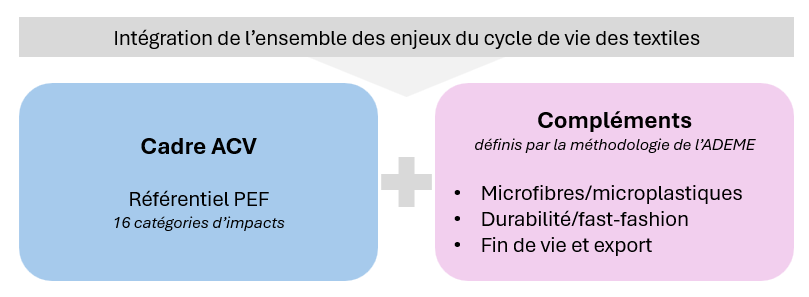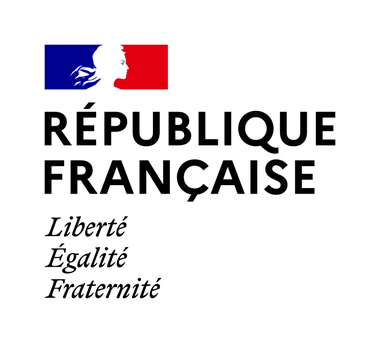Textile environmental labelling calculates the impact of each garment, taking into account all operations in its life cycle (e.g. cotton manufacturing, spinning, dyeing, finishing, transport, end-of-life).
The "environmental cost" calculation method is based on :
A few product-specific parameters, to be defined by the manufacturer/analyst (e.g. type of product: pants, tshirt etc.; type of material: cotton, linen, polyester; country of manufacture etc.). The Empreinte LCA database, which provides the environmental values (e.g. impact of 1kg cotton, 1kwh electricity, 1kg glass etc.). The calculation method, which is an enriched version of the PEF (PEF-wise approach). The method contains the PEF indicators, weighting rules and complementary indicators.
Méthodologie pour le secteur textile
En France, le dispositif d'affichage environnemental couvre les textiles d’habillement et repose sur huit étapes du cycle de vie du produit :
- L’extraction des matières premières
- La fabrication du fil et du tissu
- Les procédés d’ennoblissement
- La confection
- La distribution
- Le transport
- L’usage par le consommateur
- La gestion de la fin de vie
La méthodologie développée par l’ADEME et le ministère de la transition écologique s’appuie sur les indicateurs d’analyse du cycle de vie (ACV) définis au niveau européen dans le cadre du Product Environmental Footprint (PEF). Ces indicateurs permettent d’évaluer les impacts environnementaux liés à la consommation d’énergie et d’eau, ainsi qu’aux pratiques agricoles associées à la production textile, comme l’irrigation ou l’usage de pesticides et d’engrais. Ils sont regroupés autour de quatre grands enjeux : le climat, la biodiversité, la santé environnementale et les ressources.

Ces 16 indicateurs sont complétés par 3 éléments spécifiques au secteur textile :
- Exportation hors Europe : ce complément vise à refléter l'impact lié à la fin de vie d’une partie des produits textiles qui deviennent des déchets en dehors de l’Europe. Ce calcul repose sur la masse et la classification des matériaux (synthétiques ou naturels) utilisés dans le produit.
- Microfibres : le relargage des microfibres un impact environnemental significatif qui doit être intégré dans l’évaluation de l’impact environnemental d’un produit. Pour quantifier cet impact, deux paramètres sont analysés : la persistance (biodégradabilité) et le relargage des fibres.
- Coefficient de durabilité : ce coefficient permet d’intégrer la durabilité physique (résistance, longévité) ainsi que la durabilité non-physique (comme l’attachement émotionnel) dans la note environnementale du produit.
La durabilité non-physique est évaluée selon 2 critères : l’incitation à la réparation par la marque (rapport entre le coût moyen de réparation et un prix de vente de référence) et la largeur de gamme proposée (nombre de références).
La méthodologie actuelle intègre uniquement la durabilité non-physique puisque les travaux sur la durabilité physique n’étaient pas achevés au moment de la publication de la méthode. L’indicateur de durabilité physique sera ajouté lors des prochaines mises à jour du dispositif.

Données des produits à collecter pour le calcul du coût environnemental
Pour chacune de ces étapes, l’analyse repose sur plusieurs paramètres mais seuls quatre d'entre eux sont obligatoires :
- la catégorie du produit
- la masse finale
- les matières premières utilisées
- les localisations géographiques des étapes clés (tissage ou tricotage, ennoblissement ou impression, confection).
Sans ces données, il est impossible d’évaluer l’impact environnemental du produit. D’autres paramètres peuvent être ajoutés si l’entreprise dispose des informations nécessaires, comme le nombre de références, la durée de commercialisation, l’origine de la filature, le type d’ennoblissement ou encore la part du transport aérien. En l’absence de ces données, des valeurs par défaut majorantes, sont appliquées.
Le calcul des scores est réalisé via l’outil Ecobalyse, qui agrège les résultats selon une pondération des différentes catégories d’impact : changement climatique, consommation d’eau, eutrophisation, etc.
Une fois le calcul réalisé, les entreprises pourront déposer le calcul du coût environnemental sur le portail de déclaration.


